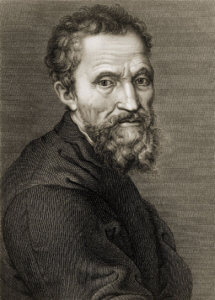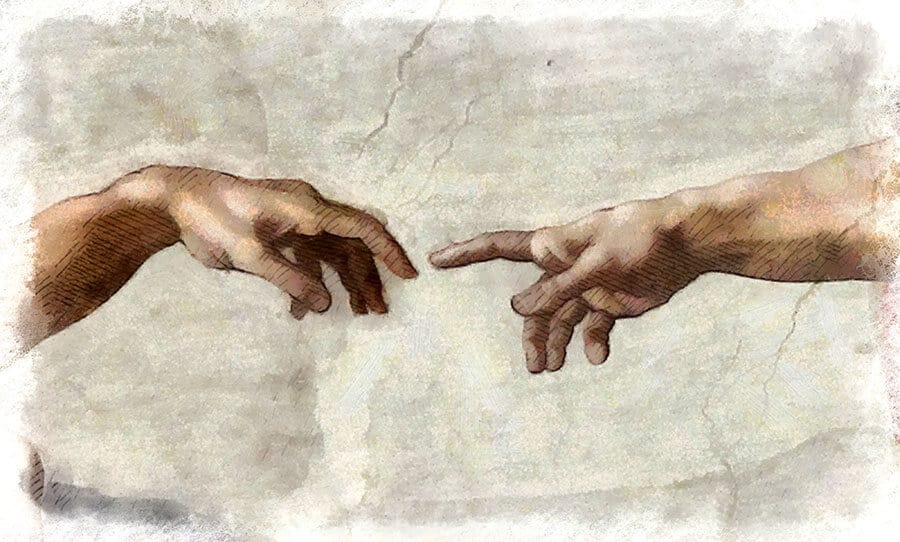Michelangelo - one of the most famous sculptors and painters, who had never wanted to be known for his pictures, rather just for his statues. Through delicate carvings out of marble, Michelangelo spoke with God and translated God’s word for mankind. He spent his life struggling and philosophizing, giving it into the hands of deep feelings, which led to a summit of artistic achievement. In the movie “Michelangelo – Infinito” the plot discovers some con artistry, a mental journey, and thoughts on the genius of Buonarroti.
“Michelangelo – Infinito”, directed by Emanuele Imbucci, features only two protagonists: Michelangelo (Enrico Lo Verso) and Giorgio Vasari (Ivano Marescotti) – one of the first biographical writers, who gave rise to the common understanding of art history. In shifting monologues, Vasari introduces significant stages in Michelangelo’s life, allowing Buonarroti to tell and reveal his thoughts and feelings, while acting out contemporaneous events.
Vasari wrote a book – “Le vite” – 178 biographical sketches about the greatest artists of the Renaissance. For centuries it was the only source for the historical facts of the artists’ lives, as one sees here with the life of Michelangelo.
Before Watching
First, the scene where Michelangelo is considering his life seems to consist of fragments of memories mixed with passions, water spots, and objects that reflect his emotions. And crafts, symbolic of his talent and hard work.
Secondly, his clothing – white and light – almost makes him seem weightless, connected with goodness and holiness. However, in the episode in which Michelangelo is imprisoned in subterranean chambers under the church basement, he wearswore black linen clothes, which evoke the darkness of this period of his life.
Last but not least, the general style of the movie. Vasari only wrote “hard fact” biography, while Michelangelo seemed to show emotions to connect with his audiences through feelings.To my mind, the general idea of the plot is to combine impressions when Michelangelo reveals his thoughts and real emotions, which are an effective method to wake up the viewers. Moreover, it draws us into the concept and allows us to see the beauty of sculpting. Vasari provides a kind of narrative, giving the chain of events a place in time.
Michelangelo di Lodovico Buonarroti Simoni

Michelangelo was born into a mason’s family. From the earliest years of his childhood he acquired basic knowledge about stone, and the implements used to work it, often said to have been served with his mother’s milk. He was taught to carve marble statues, distinguished by natural forms, light and plastic with movement. This would commonly be reflected in his later creations, distinguishing Michelangelo from other artists. All that inner strength, translated into stone, was the artist’s style, a kind of conversation, and quite often we seem to touch the depths of his soul.
However, all his life Michelangelo spent hours communicating with both God and man, and appreciating architecture. He argued with himself, convinced that must be known only for his sculptures, and not for painting. But the artist reached out to the infinite through his works, and in the end left a stunning collection of buildings and murals, paintings and marble figures.
Special signs marked him as a delicate observer, unpredictable and shadowed by risk. He always looked ahead to the final outcome, seeing gestures and lightness in the raw stone and brick. All of his marble came from Carrara, which was famous for its natural quality. The statue of David came from one, solid block, giant and massive. It’s an original interplay of light and color, geometric figures in a base that produced a masterpiece, which was presented in Florence for a first viewing in 1504. As was true of most of his works, the David statue conveys and a sense of physical struggle and philosophical repose. To begin with the first attempt to explain his life, a mass of marble is carved from its mountain home. So, all of his future works contain a piece of nature, a measure of perfection, and a stroke of the divine.
The greatest architect and fatalist
Certainly the fatalist can be seen in his Sistine Chapel, where appear episodes of the Last Judgment, episodes from the Jewish and Catholic bible, images from the Kabbalah, and perfect bodies. The Sistine Chapel is a fresco, and although Michelangelo was not entirely inexperienced, he was cool to paint. So it was a hard and gruelling job to transform vast spaces on the Chapel’s walls and ceiling.
He faced difficulties of a particular king in rebuilding the Chapel. In a flashback to earlier history, we learn that it was built in 1481. With time, cracks destroyed enormous parts of the ceiling, dividing it into two parts. Reconstruction forced Pope Julius II to invite Buonarrotti to start a long-running job which lasted almost 8 years, until the world saw the murals of the Last Judgment, Adam and Eve in exile, and Noah’s flood for the first time. But underneath it all, basic structural elements such as beams and overlapping walls required enormous efforts before the Chapel in its original configuration at all:
- In order to lay out walls and cover them with fresh colours, he removed old plaster.
- The Sistine Chapel was closed to visitors while Michelangelo was working there. To escape dust and disorder, most of the job was delayed until it was possible to go on.
- Much of the work took place in extremely hot weather. While is common in Rome, the temperatures were especially high while Michelangelo was working, especially in the summer. Dry conditions on the ground, particularly under the Chapel ceiling, probably reduced the humidity somewhat. The colors, however, came in the form of powder which absorbed part of the humidity.
- Fresco style: Michelangelo was little experienced in murals. It was hard genre of painting under any circumstances, so he used paper samples before starting to draw.
- The Jewish and Catholic bibles were in conflict. How? One must note that in the Catholic bible the forbidden fruit is an apple, while in the Jewish one it is a figue. And Adam and Eve wore figue leaves as clothing. So the essential concept of images from the Bible added as many conflicts as miracles to the work. In the end, Michelangelo decided to draw a Figue as the symbol of temptation.
- Kabbalistic code was introduced in abstract signs performed by human figures. It observed the common circuit in mass actions, as when people were holding each other and trying to grasp.
- In the book of life, Vasari mentioned that all the figures were illustrated naked, as imperfect and equal in the sight of God. However, the Popes later brought in another painter, who drew clothes on some of the figures, particularly pants. He became known as “trouserpainter”. There exists only one copy of the original murals, displayed in one Italian museum.
In the middle of his career he became the principle architect of St.Peter’s Cathedral in Vatican, which brought him to Rome for the rest of his life. It was he who designed the dome in a sphere and multistage and decorated the walls with beautiful statues, not only saints and holy figures.
Michelangelo was a significant personality, artist, philosopher, and creator. All his life he had been willing to reach for the infinite. Consequently, his marble art became a sign of the divine, symbolic of all of those who have left a profound imprint on the world.
Photos: Shutterstock
Read more reviews from the author.
Support us!
All your donations will be used to pay the magazine’s journalists and to support the ongoing costs of maintaining the site.
Share this post
Interested in co-operating with us?
We are open to co-operation from writers and businesses alike. You can reach us on our email at [email protected]/[email protected] and we will get back to you as quick as we can.









